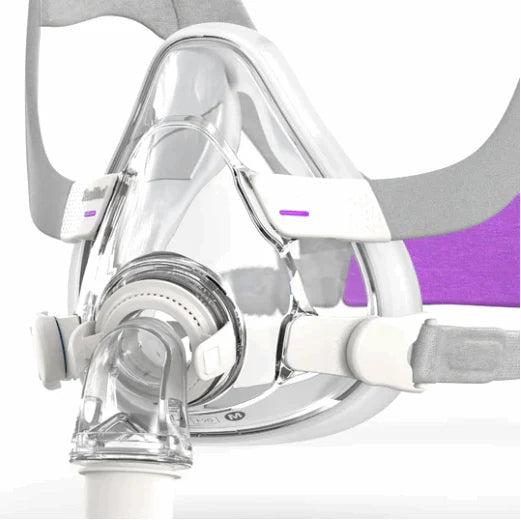L'adaptation à un nouveau masque pour le traitement de l'apnée du sommeil, la CPAP (pression positive continue), est une épreuve pour de nombreux patients. Bien que la CPAP soit destinée au traitement de l'apnée obstructive du sommeil, les premiers jours ou les premières semaines d'utilisation du masque peuvent être inconfortables. Cependant, connaître les bonnes pratiques liées à ce changement vous aidera à tirer le meilleur parti de votre traitement par CPAP. Voici quelques conseils pour faciliter au maximum la transition vers votre nouveau masque CPAP.
Comprendre la thérapie CPAP
Il existe trois types de masques CPAP : nasaux, faciaux et narinaires. Chaque type présente des avantages et des inconvénients ; il appartient donc à l'utilisateur de choisir celui qui lui convient le mieux. Par exemple, un masque facial est idéal si vous respirez par la bouche ou si vous souffrez de congestion. En connaissant les particularités de votre masque, il sera plus facile de le modifier.
Ajustement initial et confort
- Ajustement professionnel : Lorsque vous passez d'un masque facial intégral à un masque nasal, la première chose à faire est de vous assurer qu'il vous va bien. Suivez également les procédures suivantes. Les masques doivent être bien ajustés pour assurer une étanchéité et un confort optimal tout au long du port, ce que peut faire un inhalothérapeute. De nombreuses complications peuvent survenir avec le masque, notamment des fuites d'air, une gêne et des irritations cutanées.
- Ajuster les sangles : Lorsque vous recevez votre masque CPAP, il est conseillé de prendre un peu de temps pour bien enfiler les sangles. Le masque doit être bien ajusté, mais pas trop serré ; cela minimise les fuites et la création de zones de pression sur le visage. En règle générale, serrez les sangles jusqu'à ce que le masque repose délicatement sur le visage, sans pincer.
- Utilisez une doublure pour masque : En cas d'inconfort ou d'irritation cutanée, il est essentiel d'utiliser une doublure pour masque. Ces doublures peuvent également minimiser les frottements et apporter un rembourrage supplémentaire pour que vous puissiez profiter pleinement du masque.
Adaptation progressive
- Entraînez-vous à l'état d'éveil : Avant de porter un nouveau masque CPAP pendant votre sommeil, essayez de le porter en état d'éveil. Cela vous aidera à vous habituer au port du masque sur votre visage, surtout si vous n'avez pas envie de dormir. Si vous décidez de l'utiliser, commencez par le porter quelques heures, puis augmentez la durée au fil du temps.
- Commencez par les siestes : une fois habitué à porter le masque pendant la journée, vous pouvez essayer de le porter pendant de courtes siestes. Cela vous aidera à vous adapter à le porter toute la nuit sans avoir à dormir avec dès le début.
- Soyez constant : Soyez aussi constant que possible dans l'utilisation de votre nouveau masque CPAP. Essayez de le porter tous les soirs pour permettre à votre corps de s'habituer à l'appareil. Plus vous l'utiliserez, plus vite vous vous y adapterez, car il est conçu pour aider votre équipe à rattraper son retard.
Améliorer le confort pendant le sommeil
- Humidification : Si vous sentez que vos narines sont sèches ou bouchées lorsque vous portez le masque, vous pouvez utiliser un humidificateur chauffant. Cet accessoire humidifiera l'air que vous respirez, éliminant ainsi la sécheresse.
- Position de sommeil : La position allongée peut être bien plus confortable que la position assise avec un masque CPAP. Si vous dormez sur le côté, utilisez un masque CPAP pour dormir sur le côté ou essayez de changer de position pour soulager la pression du masque.
- Choix de l'oreiller : Même en ce qui concerne l'oreiller, a-t-il expliqué, il existe des différences entre les oreillers parfaits. Choisissez un oreiller compatible CPAP, adapté au port du masque, qui soutient le tube et soit confortable pendant le sommeil.
Entretien et soins réguliers
- Nettoyer votre masque : Nettoyer régulièrement votre masque CPAP est essentiel pour garantir un confort et une hygiène optimaux. Pour le nettoyer, lavez-le à l'eau tiède et au savon, en évitant tout contact avec l'huile et les bactéries, surtout pendant la journée. Lavez-le et laissez-le sécher tout seul.
- Remplacez les pièces si nécessaire : Il est important de comprendre que l'utilisation prolongée peut détériorer les composants du masque, notamment le coussinet et le harnais. Recherchez occasionnellement des signes d'usure et remplacez-les définitivement pour un ajustement et des performances optimaux.
- Surveillez votre confort : Soyez attentif à vos sensations lorsque vous portez votre masque CPAP. Si vous ressentez encore des douleurs ou des problèmes de fuites d'air, consultez votre médecin ou un spécialiste du sommeil.
Conclusion
La transition vers la nouvelle version d'un masque CPAP n'est pas simple, mais ces mesures faciliteront la transition vers un nouvel environnement confortable. Il est donc nécessaire d'aborder les questions liées à un ajustement correct, à une utilisation progressive et à la régularité pour bénéficier pleinement du traitement. En prenant le temps d'éliminer ces obstacles, vous pourrez mieux dormir et améliorer votre santé générale. N'ayez pas peur de ce changement et améliorez votre gestion de l'apnée du sommeil : votre corps vous en sera reconnaissant.

